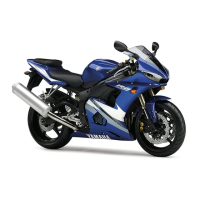CHASSIS
3-32
2. Adjust:
• Compression damping (slow compression
damping)
▼▼▼▼ ▼ ▼▼▼▼▼▼▼▼▼ ▼ ▼▼▼▼ ▼ ▼▼▼▼ ▼ ▼▼▼▼▼▼▼
a. Turn the adjusting screw “1” in direction “a” or
“b”.
▲▲▲▲ ▲ ▲▲▲▲▲▲▲▲▲ ▲ ▲▲▲▲ ▲ ▲▲▲▲ ▲ ▲▲▲▲▲▲▲
EAS21650
CHECKING THE TIRES
The following procedure applies to both of the
tires.
1. Check:
• Tire pressure
Out of specification → Regulate.
WARNING
EWA13180
• The tire pressure should only be checked
and regulated when the tire temperature
equals the ambient air temperature.
• The tire pressure and the suspension must
be adjusted according to the total weight
(including cargo, rider, passenger and ac-
cessories) and the anticipated riding
speed.
• Operation of an overloaded vehicle could
cause tire damage, an accident or an injury.
NEVER OVERLOAD THE VEHICLE.
WARNING
EWA13190
It is dangerous to ride with a worn-out tire.
When the tire tread reaches the wear limit, re-
place the tire immediately.
2. Check:
• Tire surfaces
Damage/wear → Replace the tire.
Direction “a” (turn in)
Compression damping is increased
(suspension is harder).
Direction “b” (turn out)
Compression damping is decreased
(suspension is softer).
Compression damping adjusting
positions (slow compression
damping)
Minimum
24 click(s) out*
Standard
15 click(s) out*
Maximum
1 click(s) out*
* With the adjusting screw fully turned in
a
b
1
Tire air pressure (measured on
cold tires)
Loading condition
0–90 kg (0–198 lb)
Front
250 kPa (36 psi) (2.50 kgf/cm²)
Rear
250 kPa (36 psi) (2.50 kgf/cm²)
Loading condition
90–193 kg (198–425 lb) (USA)
90–192 kg (198–423 lb) (Califor-
nia)
Front
250 kPa (36 psi) (2.50 kgf/cm²)
Rear
290 kPa (42 psi) (2.90 kgf/cm²)
High-speed riding
Front
250 kPa (36 psi) (2.50 kgf/cm²)
Rear
250 kPa (36 psi) (2.50 kgf/cm²)
Maximum load
193 kg (425 lb) (USA)
192 kg (423 lb) (California)
* Total weight of rider, passenger, cargo
and accessories
Wear limit (front)
1.0 mm (0.04 in)
Wear limit (rear)
1.0 mm (0.04 in)

